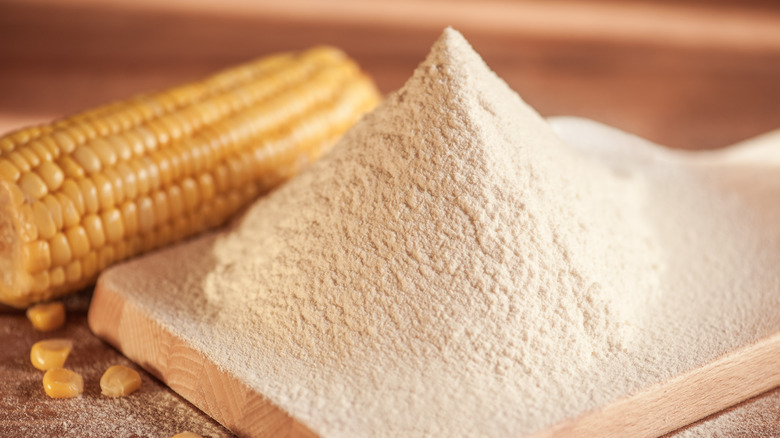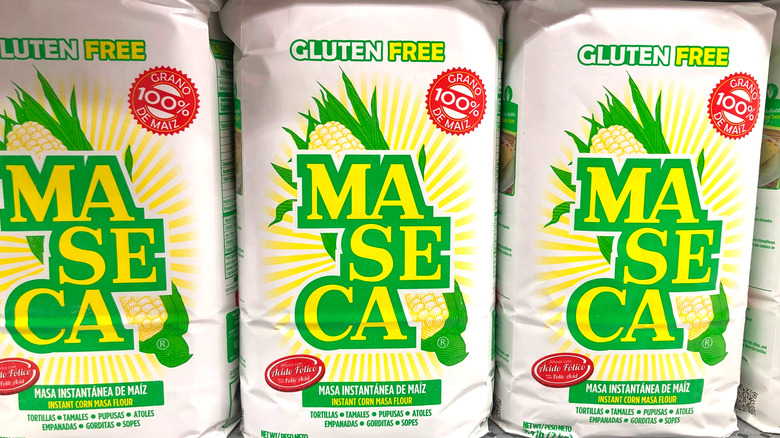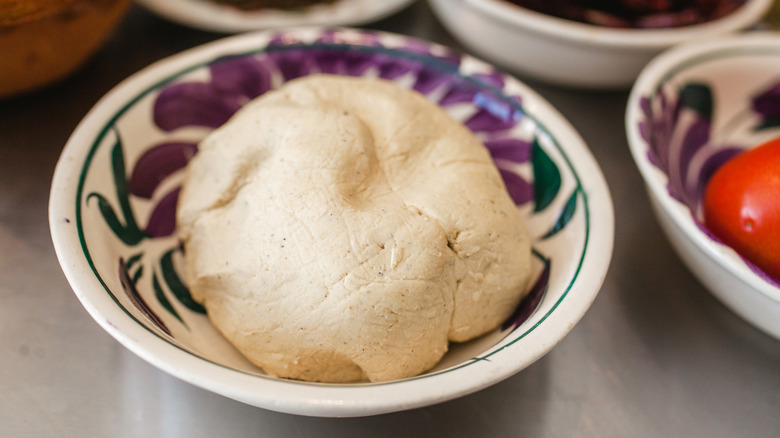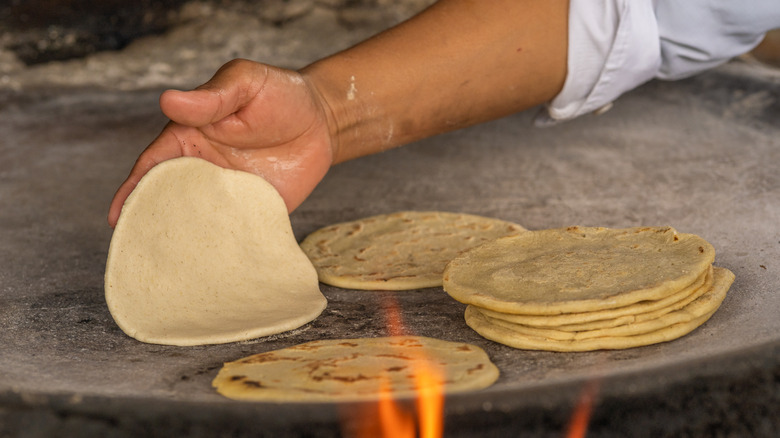The Difference Between Masa And Masa Harina
It's hard, maybe impossible, to limit different types of cuisine to just a few ingredients. For instance, while Italian cuisine is plentiful in pasta, garlic, and tomatoes, there are regions that are anchored on fish, vegetables, and bread. That said, there are still elements that are vital as certain global kitchen staples. A Japanese pantry wouldn't be complete without rice, soy, and fish, and you wouldn't venture into Chinese cookery without noodles, ginger, and sesame. Beans, chiles, and corn create the basis for many Mexican and Latin American dishes, making these ingredients vital for this type of cooking.
But you won't always find staple ingredients in their whole forms when it comes to cooking specific types of cuisines. Corn in Mexican cooking, for example, can be processed into hominy for pozole, finely ground and used for tortillas and beverages, and cooked on the cob for elotes. And any recipe utilizing ground corn will probably label it as masa harina. However, you'll also run across recipes that specify masa. Despite their similar names, if you try to substitute one for the other, you may end up with a culinary disaster — even though the two ingredients make the exact same things. Confused yet? Don't worry, we're here to help.
What is masa harina?
At its most basic, masa harina is a type of flour. "Masa" means "dough" in English, while "harina" means "flour." Masa harina is made from corn, not just dried corn. First, corn kernels are soaked in limewater and turned into hominy in a process called nixtamalization. The hominy is ground very finely and, once it's completely dried, it becomes the soft, powdery substance known as masa harina. If you've ever had homemade corn tortillas, you might have noticed a very subtle tart flavor. This comes from the corn and the process it goes through to become hominy.
While masa harina may remind you of cornmeal, the two are very different. Cornmeal is made from dried corn and is usually ground a bit coarser than masa harina. It also lacks the signature sour flavor that comes with its Latin counterpart. Sometimes called corn dough or masa flour, masa harina can be made from white, yellow, and even blue corn which will all result in a similar flavor that can be used for the same types of dishes.
How does masa relate to masa harina?
Once you get your masa harina home and are ready to cook with it, you'll need to prepare it. If you are making your own corn tortillas, your directions will have you rehydrate the masa harina with warm water. Once you've done this and mixed the two ingredients together, you've created masa. Yes, masa is just prepared masa harina. Depending on the dish you're making, you may also need to add spices or fats to the dough to achieve the right taste and consistency.
If you come across masa that has already been prepared in a Latin market, it will likely be labeled as "masa preparada" or "prepared dough." This has been made in one of two ways. Either masa harina has been mixed with water as you'd do yourself, or hominy has been ground and not yet dried to make masa harina. Either way, purchasing prepared masa dough is a convenient way to skip a step in your culinary adventures.
Masa harina can be treated just like flour, in that it has a fairly long shelf life if it is sealed and stored properly. However, once it is mixed and prepared into masa dough, it should be used fairly quickly as it has the tendency to dry out.
The many uses of masa
You already know you can make corn tortillas with your prepared masa which, by the way, is a reason unto itself to get your hands on some masa harina. Store-bought tortillas don't hold a candle to the ones you'll make in your own kitchen. But masa can be used for a number of classic Latin dishes. The holiday favorite, tamales, takes prepared masa, spreads it on a corn husk, and fills it with a number of options like pork in chili sauce, chiles, and cheese, or even sweet ingredients like pineapple or strawberry. Once wrapped and sealed in the husk, the tamales are steamed until the masa becomes solid.
Sopes, gorditas, and South America pupusas are also made with corn masa. Sopes are basically very thick corn tortillas griddled until they are cooked and topped with beans, meats, and the kind of condiments you'd put on a taco. Gorditas are not quite as thick as sopes but are a little thicker than corn tortillas. They are either stuffed or topped with the same things you'd put on a sope. Pupusas resemble thick corn tortillas, not because the masa is thick, but because they are stuffed with ingredients like cheese, beans, or vegetables.
As you can see, masa and, thus, masa harina, go into some of the most delicious foods in the world. Easy to find and work with, it's worth getting your hands on this special flour the next time you come across it.



